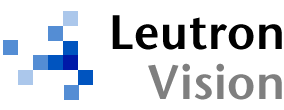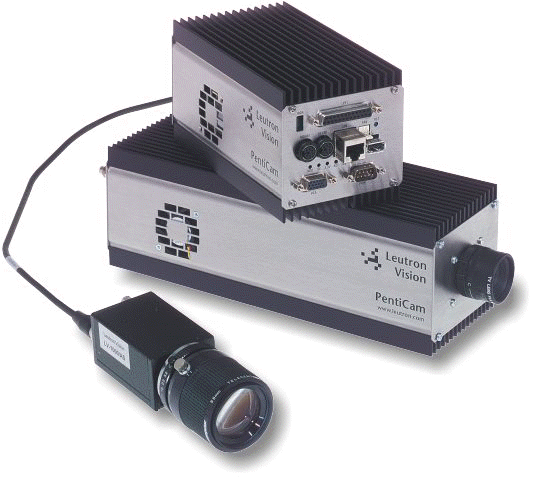
The ultimate vision system for a variety of applications.
PentiCam® is an ultra compact,
mobile image processing system for industrial and machine vision, based on
standard PC technology and Leutron's PicPort® framegrabbers. This
innovative approach provides a single step to a final solution without the
requirement for a development system.
PentiCam® is a PC, framegrabber and camera in one with:
- PicPort® framegrabbers (Picport Color or Mono or Stereo)
- complete Pentium II system
- free camera choice
- ultra small footprint
- variety of third party software available

PentiCam is a complete PC integrated with a PicPort® frame grabber and is based on a combination of notebook PC technology and PMC-size modules. It offers the ultimate integrated vision system by providing image capture from standard and non-standard cameras, Pentium II processing power, an interface to all common PC peripherals, Ethernet link for networking and general purpose I/O.
A built-in DC/DC converter board means the PentiCam requires only a single 24 Volt DC external power supply. It has a single free PMC slot and as such can be extended with many 3rd party PMC modules such as I/O, CANbus, Profibus, etc or even a second PicPort® frame grabber.
As the PentiCam is based on PC architecture it supports standard operating systems such as Windows NT, Windows 2000, Windows 95/98, and Linux, so the user is not restricted to using dedicated developing tools, often found with common «smart camera» devices. This also eliminates the need for difference between the development system and the target system - just simply connect keyboard, mouse and monitor and start working. Not only does this provide a big advantage during application development but also greatly reduces the risk associated with «field upgrades».
Existing users of Leutron's PicPort® framegrabbers can take full advantage of PentiCam simply by transferring their applications for immediate use.
PentiCam is provided in two basic configurations. The first option includes just the PC and the framegrabber, without built-in camera (dimensions of this model are 75×75×160 mm). The second includes a standard vision camera plus standard lens (75×75×250 mm). Both versions may be further configured by selecting between PicPort®-Mono, PicPort®-Stereo or Picot®-Color framegrabber, also by choosing the processor, memory size and hard disk capacity. In case of the extended type the customer can also select the required camera and lens. Quantity OEMs can purchase the board set only.
The PentiCam is based on a standard PC computer. Main specifications are:
- Intel Pentium II Mobile Module with 0.25 µm technology, 266-333 MHz
- 16 to 128 MB SDRAM, fitted as a single SO-DIMM
- AGP Graphic Controller with 4MB memory and standard 15-pin HD-sub connector, includes drivers for Windows 95/98
/NT4/2000
- COM1, optional COM2, LPT1, PS/2 Keyboard, PS/2 Mouse, USB Type A, with standard connectors, all accessible
on the external housing
- 10/100Mbit Ethernet controller
- Ultra DMA EIDE controller and floppy controller available inside the system for OEM use
- One expansion PMC slot for 3rd party modules (3.3V PCI bus )
- State of the art STANDARD BIOS, ensuring a 100% compatibility to existing desktop PCs
- 2.5" hard disk, 2 to 14 GB, shockproof.
- Compact Flash PCMCIA 50pin ATA interface allows up to 220 MB
- DC/DC converters for single 24 VDC, 30W power supply
A brief overview of PicPort®-Mono and PicPort®-Stereo framegrabbers and their features are listed below.
In general PicPort® boards accept video resolutions up to 2048×2048, 2:1 interlaced or non-interlaced mode, pixel shape in accordance with CCIR601 or square.
PicPort® Analog models accept video sources compliant with CCIR or RS170 video standards. In addition many non-standard cameras, i.e. progressive scan, can also be interfaced by utilizing an easy to use Camera Editor.
Single-channel and dual-channel cameras are supported in all operating modes.
For the PicPort® range 8 bit, 20MHz, A-to-D's are used to digitize the video input. The PicPort®-Mono has a single A to D and the PicPort®-Stereo has two. A programmable Input LUT can be used for real-time manipulation of brightness, contrast, gain and offset.
The digitized image may be scaled down (using fine mathematical interpolation algorithms), mirrored, or overlaid by arbitrary graphics. Finally, it is converted to desired target color model (RGB or monochrome with different bit depths). For display on 8-bit VGA card, the 20 Windows system colors are preserved by means of LUT; 236 grayscale values are represented on the card.
The digitized and conditioned data is transferred using two independent DMA channels directly to the CPU and/or video memory without on board intermediate storage and with minimal CPU intervention. The board acts as a PCI bus master allowing transfers at peak rates of up to 132 MB/s i.e. real time transfer for all acquisition modes.
The two independent DMA channels provide many modes of operation including simultaneous transfer of video data from a single image source to main memory for processing and to video memory for display. A dual channel camera, that outputs two fields of the same frame simultaneously, can be combined to build up a complete image in real time. Transfer of images from two synchronized cameras to two independent memory windows.
PicPort® framegrabbers are able to work in the «slave» synchronization mode (accepting CVBS, H/V or pixel clock synchronizing signals from the camera) or in the «master» mode (controlling camera timing by providing H/V or pixel clock synchronization). Furthermore, they are able to work in asynchronous (triggered) mode.
All the PMC based PicPort®-Mono/Stereo framegrabbers are equipped with a single all-purpose HD-sub 44-pin connector.
In addition to the video inputs the PMC models are all capable of H/V and pixel clock I/O , 8 programmable opto-isolated general purpose I/O lines and are complete with a 12VDC power supply for the camera.
The video interface is model specific:
PicPort®-Mono-PMC features 4 video inputs, where only one each
input may be digitized at a time via a single digitizer.
PicPort®-Stereo-S-PMC has also 4 video inputs, but two of them
may be digitized simultaneously via two digitizers.
Finally, PicPort®-Stereo-D-PMC has 4 video inputs as well, but is
intended for dual-channel cameras where only one dual-channel camera can be
digitized at a time.
PentiCam is based on world's most widespread platform - Windows NT, Windows 2000, Windows 95/98. This enables the user to work in familiar environment, with familiar tools and with full compatibility to existing applications. Moreover, the Linux platform is supported as well.
Leutron Vision Software Development Suite, LV-SDS, is a software development package (Windows, Linux) that allows full control of all PicPort® products. The suite consists of Daisy - the primary software interface for PicPort® cards, Camera Editor - simple interactive setup of standard and non-standard cameras, DRAL - a library for handling specific time-critical tasks, DirectCapture - higher level library for the simple design of live-video Windows applications, TWAIN Driver and Video for Windows - provides a simple interface between Leutron Vision hardware and other image manipulation programs.
Language and hardware independent library with many groups of powerful image processing functions. It is a robust tool for programming vision and measurement applications in industry, research and scientific areas.
Several well-known third party packages for image processing and analysis such as Halcon, Vision Blox, NeuroCheck etc. are also supported. Please refer to our detailed software brochure for more details.
The software products come complete with a set of demo programs and additional examples with source code as a guide to the programmer in developing particular applications.
| Bus interface | PMC IIIE1386.1; based on PCI Revision 2.1 |
| OS support | Windows NT, Windows 2000, Windows 95/98, Linux |
| Host processor | Intel Pentium II Mobile Module MMC-2 |
| Memory | 16-256 MB SDRAM, standard SO DIMM |
| Main board | standard BIOS, EIDE/UDMA controller, floppy controller, 10/100Mbit Ethernet controller |
| Graphic controller | on mainboard, AGP, 4 MB memory |
| Storage devices | 2.5" HDD, 2-14 GB, shockproof, Compact FlashDisk PCMCIA 50pin ATA interface |
| Expadability | 1 PMC expansion slot (3.3V PCI bus) |
| Image inputs | up to 8; CCIR, RS170, nonstandard |
| Image geometry | 2:1
interlaced, noninterlaced, progressive, dual channel; resolution programmable up to 2048×2048; pixel shape CCIR601, square, programmabel |
| Frame grabbers | PicPort®-Mono/Stereo/Color, PMC modules |
| Data digitization | up to 20MHz, 8-bit per channel or YUV 4:2:2 |
| Image coding | 8-bit luminance or YUV 4:2:2 |
| Digitizing parameters | input LUTs, brightness and contrast, gain, offset, all independently programmable |
| Image preprocessing | interpolative downscaling, H/V mirroring, overlay, color format conversion |
| Transfer from grabber to host | bus master burst DMA transfer, peak rate up to 132 MB/s, real time for all acquisition modes |
| Synchronization | from
CVBS, H/V, pixel synchronized; as slave or master |
| Asynchronous acquisition | by external HW trigger |
| Plugs for video | HD-sub 44-pin female all purpose connector (video inputs, synchronization i/o, camera power, 8 × opto-isolated i/o) |
| Other i/o | COM1 (opt. COM2), IrDA, LPT1, PS/2 Keyboard, PS/2 Mouse, VGA, USB, Ethernet 10/100Mbit |
| Dimensions | aprox.
75×75×160 mm w/o built-in camera aprox. 75×75×250 mm with camera |
| Power requirements | 24 Volt DC, 30 W |
| Operating temperature | 0-40 °C |